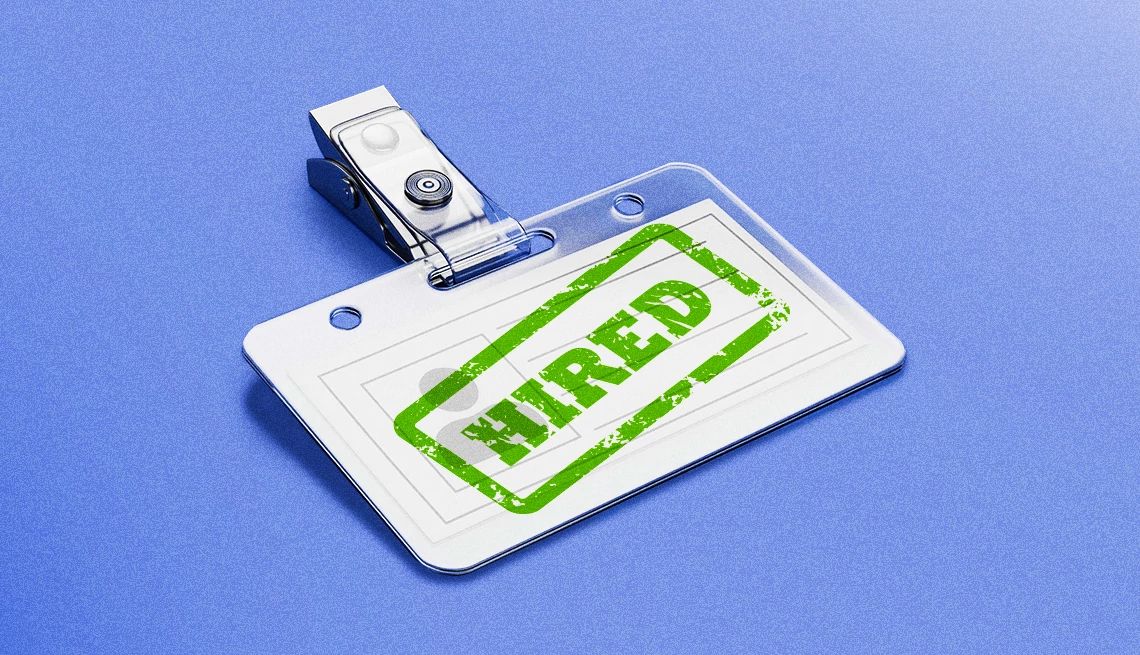AARP Hearing Center


Finding a new job can be difficult, no matter what your age is. But for older workers, it can be harder to get hired than it is for younger job seekers. A 2024 survey from the nonprofit Transamerica Institute found that, when asked at what age was a candidate “too old” for the job, 35 percent of employers named a specific age, with the median being 58.
While such overt age bias can be discouraging, experts say that older workers still have opportunities to land rewarding roles, whether they’re re-entering the job market or making a career change. A little preparation and a focus on debunking possible preconceived notions can make a difference. Here are some strategies and resources that can not only help you compete in today's job market, but also overcome age-related biases and maximize your marketability.
STARTING YOUR JOB SEARCH


1. Build belief in yourself
Before you start your job search, take a moment to make sure you’re not sabotaging yourself with lowered expectations. “One of the most important things you can do is to really examine the limiting beliefs you have around being over 50 and try to reframe them,” says career coach Bonnie Marcus, author of Not Done Yet! How Women Over 50 Regain Their Confidence & Claim Workplace Power. She says holding such beliefs can materialize in how you present yourself in correspondence, conversation and body language, undermining your chances of getting hired. For example, you might have a tendency to use minimizing language like, “Oh, I just did this,” instead of more powerful language that could really help you stand out, Marcus says. When talking with your friends, family and network about your job search, pay attention to the language you use and choose words that build your confidence.
2. Tackle your own age bias
If you do identify concerns or internal biases about your age, work on reframing those attitudes, Marcus says. If you’re feeling “too old” to get another job or like no one will hire you, turn those beliefs around. “Reframe that to something like, ‘I have the wisdom and experience to add value, to help organizations reach their objectives,’” she says. Begin to practice that by writing it out, Marcus says.
For example, you might take a lesson from researchers at Washington State University and the University of California, Irvine. In 2024, they studied entrepreneurs who were pitching their businesses to investors. The researchers found that when the business owners were able to reframe their anxiety about the pitch and connect it to their passion for the venture, they scored higher on their pitch performances.
3. Take inventory of your job skills
In an October 2023 survey by online education platform edX, the executives who responded estimated that half (49 percent) of the skills that existed in their workforce at the time would not be relevant within two years. That means it’s important to show prospective employers you have skills that will continue to be important to them.
For example, a common bias about older workers is that they’re not good with technology, says Jacob Binke, a recruiter with The Birmingham Group, a recruiting firm in Berkley, Michigan. Hiring managers might “be wary” that older workers won’t have the greatest tech skills. Be sure to highlight how you use technology. For instance, if you have worked with software programs popular in your industry, list them on your résumé.
4. Show them why you’re valuable
As you prepare for the job hunt, you’ll be working on a list of your skills and accomplishments. However, Marcus urges job seekers to think about their value proposition. “It's really an a-ha moment when you get away from what your job description is and you realize ‘This is how I can add value to an organization,’” she says.
Are you a great problem-solver or an exceptional deal-closer? Understand how your work leads to positive business outcomes, she advises. “It's a foundation of not only how you promote yourself, but how you understand yourself,” she adds. Write and memorize a sentence that describes your value. For example, “my communication and organization skills enable teams to achieve goals.”
5. Take time to build job skills
If you want to improve your skills in certain areas, consider trying an online class or getting a certification, Binke suggests. These efforts, which typically can be done at your own pace, show you’re motivated to keep your skills current and you’re interested in adding to your capabilities.
Online learning platforms like Coursera, LinkedIn Learning, Udemy, AARP Skills Builder for Work and others have free or low-cost courses in a variety of areas ranging from leadership and management to specific software packages. You might also check out online and in-person courses through industry associations, your local community college or other continuing-education programs.
Enjoying this free Members Edition article?
AARP Members can enjoy more Members Editions content here.
Not a member? Join Today! And unlock access to exclusive members-only content, games, benefits, and more.
6. Trim your résumé
While it’s smart to add skills and certifications to your résumé, there are some things you may wish to cut. It’s a good idea to focus your experience on the past 10 to 15 years at most, says career consultant John Bates, known as the Job Guy, who has helped coach more than 1,700 professionals into new jobs. “If a job is asking for five to eight [years of experience] and you have 27, that’s going to be a knock-out factor,” he says. In general, your résumé should be no more than two pages. In some cases, it may be worthwhile to include jobs from more than 15 years, but those sections should be shorter than the sections detailing your more recent roles. You might also consider leaving out specific years or times.
7. Use the right keywords
While you’re editing that résumé (and, while you’re at it, your LinkedIn profile), make sure you include the keywords that matter most for your intended job. Résumés are increasingly filtered through software platforms known as applicant tracking systems (ATS) that search for words in your résumé that match the keywords in the job posting. As you read job ads, note commonly used words for skills, experience or other attributes companies want, then integrate those into your résumé and LinkedIn profile. “They're going to use a lot of the same keyword mechanisms in their LinkedIn searches for candidates as they would if they're going through the résumé pool,” Bates says. If you’re uncertain about which keywords you should include, try uploading both your résumé and the job posting into a program such as ChatGPT or Copilot and ask the program to optimize your résumé to match the job opening. But always review the new résumé for errors, because artificial intelligence programs can introduce inaccuracies.
FINDING JOB OPENINGS


8. Build your social media presence
Your social media presence can cast you in the best possible light to prospective employers, Marcus says. She recommends being active on LinkedIn, adding coworkers and other contacts to your network and interacting with people in your field. You should also consider posting informative content and thoughts about your industry.




































































You Might Also Like
25 Great Ways to Deal with Burnout
Tips to spark your purpose and energy while at work — and into retirementOut of Work and Worried
Advice on how to cut spending and where to pull money from if you lose your job in your 60s
Why I Socked Away Over $500,000 in a ‘Layoff Fund’
Building a financial cushion was a game changer. Here’s how I did it